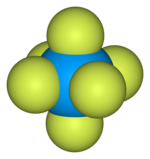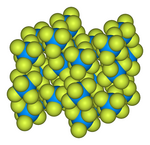Uranium hexafluoride
You can help expand this article with text translated from the corresponding article in German. (November 2012) Click [show] for important translation instructions.
|

| |

| |

| |
| Names | |
|---|---|
| IUPAC names
Uranium hexafluoride
Uranium(VI) fluoride | |
| Identifiers | |
3D model (JSmol)
|
|
| ChEBI | |
| ChemSpider | |
| ECHA InfoCard | 100.029.116 |
PubChem CID
|
|
| RTECS number |
|
| UN number | 2978 (<1% 235U) 2977 (>1% 235U) |
CompTox Dashboard (EPA)
|
|
| |
| |
| Properties | |
| UF6 | |
| Molar mass | 352.02 g/mol |
| Appearance | colorless solid |
| Density | 5.09 g/cm3, solid |
| Melting point | 64.052 °C (147.294 °F; 337.202 K) (triple point at 151 kPa[1]) |
| Boiling point | 56.5 °C (133.7 °F; 329.6 K) (sublimes) |
| Reacts violently | |
| Solubility | soluble in chloroform, CCl4, liquid chlorine and bromine dissolves in nitrobenzene |
| Structure | |
| Orthorhombic, oP28 | |
| Pnma, No. 62 | |
| octahedral (Oh) | |
| 0 | |
| Thermochemistry | |
Std molar
entropy (S⦵298) |
– solid: −430,4 ± 1,5 J·K−1·mol−1[2]
– gaseous: −280,4 ± 1,5 J·K−1·mol−1[2] |
Std enthalpy of
formation (ΔfH⦵298) |
– solid: −(2197,7 ± 1,8) kJ·mol−1[2]
– gaseous: −(2148,1 ± 1,8) kJ·mol−1[2] |
| Hazards | |
| Flash point | Non-flammable |
| Safety data sheet (SDS) | ICSC 1250 |
| Related compounds | |
Other anions
|
Uranium hexachloride |
Other cations
|
Neptunium hexafluoride Plutonium hexafluoride |
Related uranium fluorides
|
Uranium(III) fluoride Uranium(IV) fluoride Uranium(V) fluoride |
Except where otherwise noted, data are given for materials in their standard state (at 25 °C [77 °F], 100 kPa).
| |
Uranium hexafluoride (Template:UraniumTemplate:Fluorine), referred to as "hex" in the nuclear industry, is a compound used in the uranium enrichment process that produces fuel for nuclear reactors and nuclear weapons. It forms solid grey crystals at standard temperature and pressure, is highly toxic, reacts violently with water and is corrosive to most metals. It reacts mildly with aluminium, forming a thin surface layer of AlF3 that resists further reaction.
Preparation
Milled uranium ore—U3O8 or "yellowcake"—is dissolved in nitric acid, yielding a solution of uranyl nitrate UO2(NO3)2. Pure uranyl nitrate is obtained by solvent extraction, then treated with ammonia to produce ammonium diuranate ("ADU", (NH4)2U2O7). Reduction with hydrogen gives UO2, which is converted with hydrofluoric acid (HF) to uranium tetrafluoride, UF4. Oxidation with fluorine yields UF6.
During nuclear reprocessing, uranium is reacted with chlorine trifluoride to give UF6:
- U + 2 ClF3 → UF6 + Cl2
Properties
Physical properties
At atmospheric pressure, it sublimes at 56.5 °C.[3]

The solid state structure was determined by neutron diffraction at 77 K and 293 K.[4][5]
-
Ball-and-stick model of the unit cell of uranium hexafluoride[6]
-
Bond lengths and angles of gaseous uranium hexafluoride[7]
Chemical properties
It has been shown that uranium hexafluoride is an oxidant[8] and a Lewis acid that is able to bind to fluoride; for instance, the reaction of copper(II) fluoride with uranium hexafluoride in acetonitrile is reported to form copper(II) heptafluorouranate(VI), Cu(UF7)2.[9]
Polymeric uranium(VI) fluorides containing organic cations have been isolated and characterised by X-ray diffraction.[10]
Application in the nuclear fuel cycle

UF6 is used in both of the main uranium enrichment methods — gaseous diffusion and the gas centrifuge method — because it has a triple point at 64.05 °C (147 °F, 337 K) and slightly higher than normal atmospheric pressure. Fluorine has only a single naturally-occurring stable isotope, so isotopologues of UF6 differ in their molecular weight based solely on the uranium isotope present.[11]
All the other uranium fluorides are nonvolatile solids that are coordination polymers.
Gaseous diffusion requires about 60 times as much energy as the gas centrifuge process: gaseous diffusion-produced nuclear fuel produces 25 times more energy than is used in the diffusion process, while centrifuge-produced fuel produces 1,500 times more energy than is used in the centrifuge process.
In addition to its use in enrichment, uranium hexafluoride has been used in an advanced reprocessing method (fluoride volatility), which was developed in the Czech Republic. In this process, used oxide nuclear fuel is treated with fluorine gas to form a mixture of fluorides. This mixture is then distilled to separate the different classes of material.
Storage in cylinders

About 95% of the depleted uranium produced to date is stored as uranium hexafluoride, DUF6, in steel cylinders in open air yards close to enrichment plants.[citation needed] Each cylinder contains up to 12.7 tonnes (or 14 US tons) of solid UF6. In the U.S. alone, 560,000 tonnes of depleted UF6 had accumulated by 1993.[citation needed] In 2005, 686,500 tonnes in 57,122 storage cylinders were located near Portsmouth, Ohio, Oak Ridge, Tennessee, and Paducah, Kentucky.[12][13]
The long-term storage of DUF6 presents environmental, health, and safety risks because of its chemical instability. When UF6 is exposed to moist air, it reacts with the water in the air to produce UO2F2 (uranyl fluoride) and HF (hydrogen fluoride) both of which are highly corrosive and toxic. Storage cylinders must be regularly inspected for signs of corrosion and leaks. The estimated lifetime of the steel cylinders is measured in decades.[14]
There have been several accidents involving uranium hexafluoride in the United States, including a cylinder-filling accident and material release at the Sequoyah Fuels Corporation in 1986.[15][16] The U.S. government has been converting DUF6 to solid uranium oxides for disposal.[17] Such disposal of the entire DUF6 inventory could cost anywhere from $15 million to $450 million.[18]
References
- ^ http://www.ibilabs.com/Uranium%20Hexafluoride.htm
- ^ a b c d Johnson, Gerald K. (1979). "The Enthalpy of Formation of Uranium Hexafluoride". The Journal of Chemical Thermodynamics. 11 (5): 483–490. doi:10.1016/0021-9614(79)90126-5.
- ^ Brickwedde, Ferdinand G.; Hoge, Harold J.; Scott, Russell B. (1948). "The Low Temperature Heat Capacities, Enthalpies, and Entropies of UF4 and UF6". J. Chem. Phys. 16: 429–436. doi:10.1063/1.1746914.
- ^ J. H. Levy; John C. Taylor; Paul W. Wilson (1976). "Structure of Fluorides. Part XII. Single-Crystal Neutron Diffraction Study of Uranium Hexafluoride at 293 K". J. Chem. Soc. Dalton Trans. (3): 219–224. doi:10.1039/DT9760000219.
- ^ J. H. Levy, J. C. Taylor and A. B. Waugh (1983). "Neutron Powder Structural Studies of UF6, MoF6 and WF6 at 77 K". Journal of Fluorine Chemistry. 23: 29–36. doi:10.1016/S0022-1139(00)81276-2.
- ^ J. C. Taylor, P. W. Wilson, J. W. Kelly: „The structures of fluorides. I. Deviations from ideal symmetry in the structure of crystalline UF6: a neutron diffraction analysis", Acta Crystallogr., 1973, B29, p. 7–12; doi:10.1107/S0567740873001895.
- ^ Kimura, Masao; Schomaker, Werner; Smith, Darwin W.; Bernard (1968). "Electron‐Diffraction Investigation of the Hexafluorides of Tungsten, Osmium, Iridium, Uranium, Neptunium, and Plutonium". J. Chem. Phys. 48 (8): 4001–4012. doi:10.1063/1.1669727.
- ^ G. H. Olah; J. Welch (1978). "Synthetic methods and reactions. 46. Oxidation of organic compounds with uranium hexafluoride in haloalkane solutions". J. Am. Chem. Soc. 100 (17): 5396–5402. doi:10.1021/ja00485a024.
- ^ J. A. Berry; R. T. Poole; A. Prescott; D. W. A. Sharp; J. M. Winfield (1976). "The oxidising and fluoride ion acceptor properties of uranium hexafluoride in acetonitrile". J. Chem. Soc. Dalton Trans. (3): 272–274. doi:10.1039/DT9760000272.
- ^ S. M. Walker; P. S. Halasyamani; S. Allen; D. O'Hare (1999). "From Molecules to Frameworks: Variable Dimensionality in the UO2(CH3COO)2·2H2O/HF(aq)/Piperazine System. Syntheses, Structures, and Characterization of Zero-Dimensional (C4N2H12)UO2F4·3H2O, One-Dimensional (C4N2H12)2U2F12·H2O, Two-Dimensional (C4N2H12)2(U2O4F5)4·11H2O, and Three-Dimensional (C4N2H12)U2O4F6". J. Am. Chem. Soc. 121 (45): 10513–10521. doi:10.1021/ja992145f.
- ^ "Uranium Enrichment and the Gaseous Diffusion Process". USEC Inc. Retrieved 2007-09-24.
- ^ "How much depleted uranium hexafluoride is stored in the United States?". Depleted UF6 FAQs. Argonne National Laboratory.
- ^ Documents
- ^ "What is DUF6? Is it dangerous and what should we do with it?". Institute for Energy and Environmental Research. 2007-09-24.
- ^ "Have there been accidents involving uranium hexafluoride?". Depleted UF6 FAQs. Argonne National Laboratory.
- ^ "Uranium Hexafluoride (UF6) Tailings: Characteristics, Transport and Storage at the Siberian Chemical Combine (Sibkhimkombinat) Tomsk" (briefing note). Large and Associates. 5 November 2005. Retrieved 2007-09-24.
- ^ "What is going to happen to the uranium hexafluoride stored in the United States?". Depleted UF6 FAQs. Argonne National Laboratory.
- ^ "Are there any currently-operating disposal facilities that can accept all of the depleted uranium oxide that would be generated from conversion of DOE's depleted UF6 inventory?". Depleted UF6 FAQs. Argonne National Laboratory.
Literature
- Gmelins Handbuch der anorganischen Chemie, System Nr. 55, Uran, Teil A, p. 121–123.
- Gmelins Handbuch der anorganischen Chemie, System Nr. 55, Uran, Teil C 8, p. 71–163.
- R. DeWitt: Uranium hexafluoride: A survey of the physico-chemical properties, Technical report, GAT-280; Goodyear Atomic Corp., Portsmouth, Ohio; 12. August 1960; doi:10.2172/4025868.
- Ingmar Grenthe, Janusz Drożdżynński, Takeo Fujino, Edgar C. Buck, Thomas E. Albrecht-Schmitt, Stephen F. Wolf: Uranium, in: Lester R. Morss, Norman M. Edelstein, Jean Fuger (Hrsg.): The Chemistry of the Actinide and Transactinide Elements, Springer, Dordrecht 2006; ISBN 1-4020-3555-1, p. 253–698; doi:10.1007/1-4020-3598-5_5 (p. 530–531, 557–564).
- US-Patent 2535572: Preparation of UF6; 26. December 1950.
- US-Patent 5723837: Uranium Hexafluoride Purification; 3. March 1998.
External links
- Simon Cotton (Uppingham School, Rutland, UK): Uranium Hexafluoride.
- Uranium Hexafluoride (UF6) – Physical and chemical properties of UF6, and its use in uranium processing – Uranium Hexafluoride and Its Properties
- Import of Western depleted uranium hexafluoride (uranium tails) to Russia
- Uranium Hexafluoride in www.webelements.com

![Ball-and-stick model of the unit cell of uranium hexafluoride[6]](http://upload.wikimedia.org/wikipedia/commons/thumb/c/c6/Uranium-hexafluoride-unit-cell-3D-balls.png/180px-Uranium-hexafluoride-unit-cell-3D-balls.png)
![Bond lengths and angles of gaseous uranium hexafluoride[7]](http://upload.wikimedia.org/wikipedia/commons/thumb/4/4c/Uranium_hexafluoride_dimensions.svg/180px-Uranium_hexafluoride_dimensions.svg.png)

